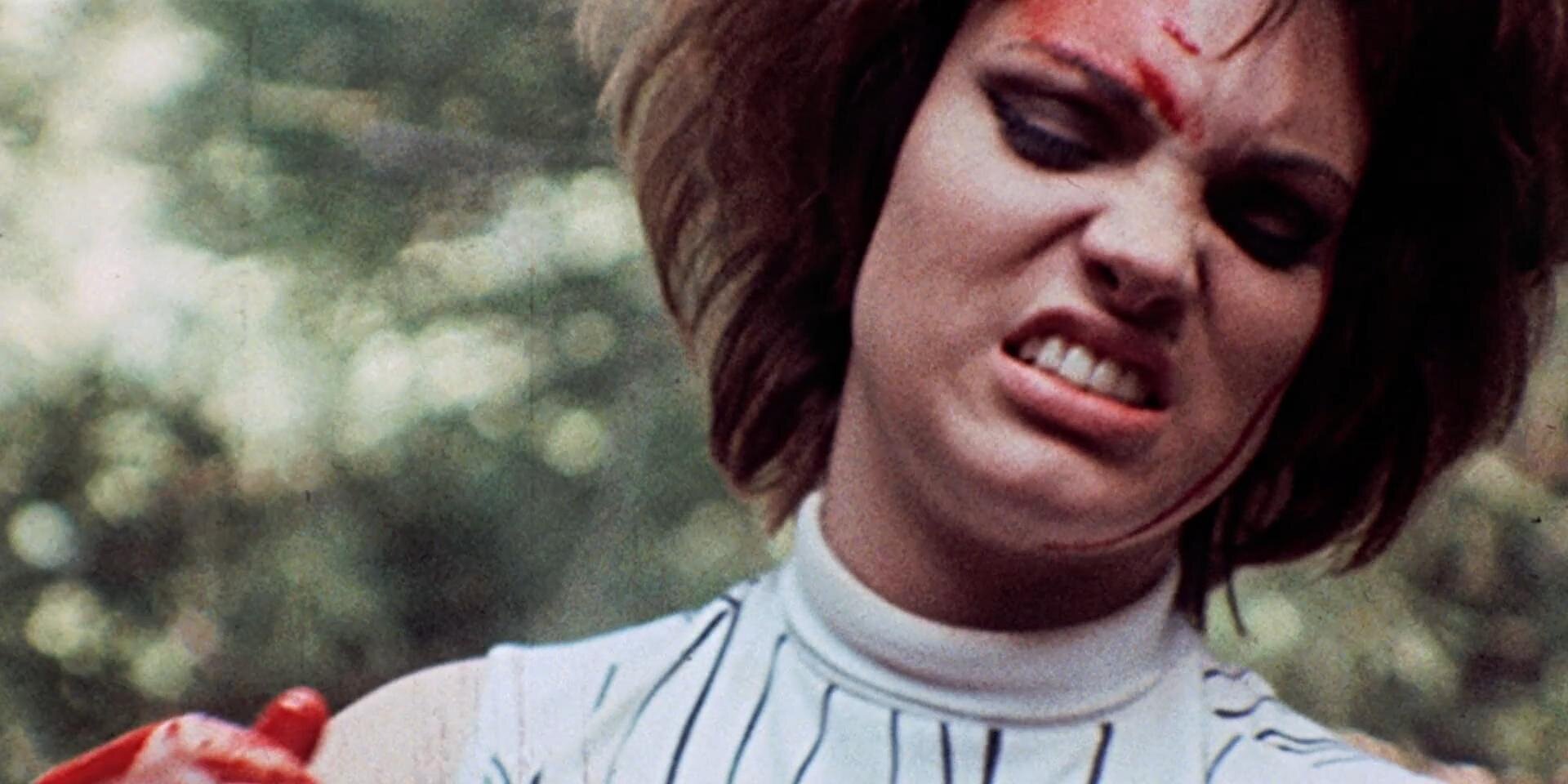The Depraved Bisexuality of The Last House on the Left
By Alex Hall
Depictions of violent women are not new to horror cinema. Vicious women, while often pathologized, are easily canonized as queer through their transgressive displays of erotic depravity. Wes Craven’s 1972 debut feature The Last House on the Left is a grisly examination of the ways violence is inflicted not only onto women but by women. Specifically exhibited through Jeramie Rain’s Sadie, Last House depicts her as a perpetrator and victim of woman-on-woman violence, a violation that feels particularly unsettling because it’s so scarcely examined. Rarer still, is this depiction within the vast subgenre of rape-revenge cinema. Predating I Spit on Your Grave (1978) by six years and Ms .45 (1981) by nine, Last House provides an examination of women violating other women, setting a complicated queer precedent.
Designated a “nihilistic nasty” by film writer Chas Balun, Last House’s exploitation mode instills gritty voyeurism that inadvertently enhances the realism of Sadie’s queer tendencies. Her sexuality is uninhibited and can be cited as an example of the “depraved bisexual” figure. For example, it is her desire for “more girls” that leads to the abduction of the film’s protagonist, Mari (Sandra Peabody) and her friend, Phyllis (Lucy Grantham). Despite calling her male counterparts “chauvinist dogs,” at times Sadie becomes equally predatory in her sexualized treatment of women. While it is Krug (David Hess) who enacts the majority of violence against Phyllis, the camera insists on capturing Sadie’s knife (the dyke “puh-hay-lis”) striking the climactic blow. Described by feminist film theorist, Carol Clover as a “blatantly phallic murder”, in her seminal text Men, Women, and Chain Saws (1992), it is a cinematic la petite mort.
Perhaps deserving of her own characterization of “Sadie-masochism,” her penetration of the victimized, female body does not stop there; in her excess, she is desiring of more. In pushing the boundaries of her perversion, she is seen reaching into Phyllis’ exposed body cavity and disembowelling her with her hands. This extends the physical violation from blade/flesh to direct flesh on flesh. Sadie’s disembowelling of Phyllis is the kind of carnal violation described by Clover as bringing the attacker and the attacked into a “primitive, animalistic embrace.” Here, Sadie renders Phyllis (literally) gutless, a punishment for her precocious defiance. Through Sadie, there remains a cautionary tale of how pretty girls rot.
With her complicated working-class, criminal origins and knowledge of feminist theory and psychoanalysis, Craven grants Sadie nuance in a refusal to fully demonize her. She attributes Sigmund “Frood” as the “sex criminal of the century” for intellectualizing her perversion and more specifically, her bisexuality. Through Freud’s influence, everything, according to Sadie, becomes sexualized, confessing that even the gaping crevice of the Grand Canyon arouses her.
As such, Sadie’s sexuality is continually bound to the natural world. During Phyllis’ assault, Sadie offers to help her escape. Instead, Phyllis attacks her with a rock while slurring “stupid dyke,” very bluntly aligning Sadie’s queerness with the rugged landscape and sadomasochistic pain. It’s a connection that acknowledges the unrefined and brute forms of animalism within her as a refusal for taming, or assimilation.
Consider how her screen presence begins and ends with her submerged in water. Bodies of water remain realms in which Sadie is spatially severed from men. The bathtub at the beginning lends itself to the fluidity of identity, becoming a mechanism for self-reinvention (“Agatha Greenwood”) as much as the suburban pool at the end becomes a burial ground—Estelle (Cynthia Carr) slitting her throat into a vulvic fissure.
Water remains a motif throughout. While both women are shown bathing upon introduction, Mari’s showering exemplifies a baptismal purity, in which her body is veiled discreetly behind frosted glass while Sadie’s indicates the inverse. Her body is exposed, steeping in a filthy motel bathtub. Instead of initiating a form of cleansing, Sadie appears to revel in the grime. And, unlike the sparkling stream Mari and Phyllis sit by as they discuss their virginal bodies, Sadie, in comparison, contaminates every body of water she touches. She isn’t granted the re-christening Mari is when fatally submerged, instead, she becomes a threatening pollutant disintegrating the pristine affluent environment of the Collingwood's home, desecrating the American hetero-nuclear family.
As she bathes, a news report warns the public of Sadie and her clan, characterizing her as “young, strong and animal-like,” a description reinforcing her natural impulses as bestial. In the bath, she admires herself in a silver compact. Through a low-angle closeup, the mirror eclipses her face. Evocative of an animal preening under a full moon, she basks in the hedonism of dirt-femme pleasures.
Sadie’s devotion to herself requires an altar of feminine artifacts typically considered frivolous; pink curlers, red lipstick, lavish perfume bottles perched on the rim of the tub. As Arabelle Sicardi notes, "beauty is terror and a vehicle of power. But power and terror, in our reality, are the same thing." There is an unsettling, anarchic quality to Sadie’s preening. Her sing-song tone is snarled and crass, her blood-red nails grip a cheap can of beer and her makeup is a garish caricature of womanhood typically cultivated by drag queens (see: Divine’s rendition of depraved bisexuality in Pink Flamingos, 1972).
As she suggestively sucks the tip of her lipstick (praise be the femme phallus!), her makeup application appears as excessive as her sexuality, exaggerating her monstrous high femme camp antics. In his manifesto on Camp/Anti Camp, filmmaker Bruce LaBruce remarks that “strippers, street-smart drag queens, female porn stars and hookers have often evinced a radically exaggerated appearance that transcends and deflects patriarchal co-optation.” Sadie’s expression of gender easily transgresses a straight optic of beauty, especially compared to the heteronormative (i.e., minimalist) appearances of Last House’s other women. As Sicardi further notes, “We’re not taught how to own ourselves. We’re taught to make the labour of selfhood invisible, and look easy.” Sadie actively draws attention to the effort applied to her queer femininity; every stroke is revealed in a spectacle of over-application. In marking her body she asserts her selfhood visually before reasserting it verbally—“I’m my own friggin’ woman!”
While bathing, Sadie crudely recites the words to “Singing in the Rain.” Notably performed by Gene Kelly in 1952, and Malcolm McDowell in Stanley Kubrick’s A Clockwork Orange (1971), the song queers Sadie further. Rain bastardizes the song through farce, dismantling the hyper-masculinity of its canonical male performances. In its reappropriation Sadie dilutes the song further, rendering its original context impotent. Her ridiculing tone debases the celebration of heteronormative idolatry associated with Kelly’s iconic stardom, subverting hetero-masculinity into hyper-femininized parody. Here, the film’s use of a capella allows other sounds to fill in the orchestral blanks; the splashing of Sadie’s bathwater lending itself to an evocation of queer libido and self-pleasuring. In redirecting its original expression of amorous affection back onto herself, Sadie repurposes masculine joy into an expression of feminine pleasure.
It is in these expansive, watery spaces that Sadie is fully seen, centered and dominant in the frame. Yet, within these moments, there remains an uncertain embodiment exposing queerness in all of its bare grotesqueries. Craven encourages a complex examination of the cyclical nature of feminine volatility in both Sadie’s lived experience as a violator and in the fatal violence she sustains at the hands of the Collingwood matriarch. In the end, the transgressive body of the depraved bisexual in Last House exists beyond the liminal; forever occupying a disruptive position outside the bounds of acceptibitlity.
Alex Hall is a film writer & dog walker based in Toronto. She is the creator of Lezzie Borden, an Instagram account that examines and archives depictions of queer women in horror. Her work can be found in Grim, Rue Morgue, Gayly Dreadful & Dyke Queen. Most recently, she has contributed a chapter to a forthcoming book of essays on Queer Horror. Find her on Instagram at @lezzie_borden and on Twitter @tinyspritizies
We've been going independently for years now, and so far have self-financed every single project. In order to do more work, and continue supporting amazing filmmakers in the genre space, we've launched a Patreon.
If you are able to support us and the work we do on Patreon, we'd truly and deeply appreciate it.


